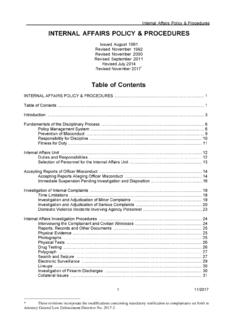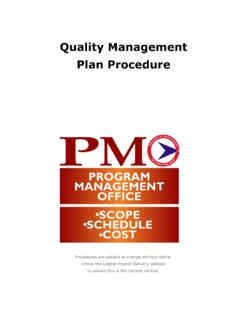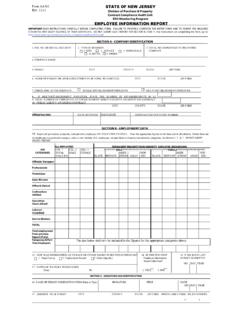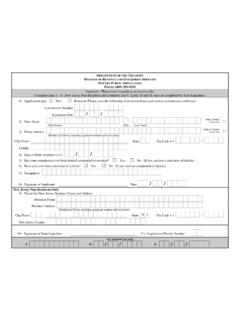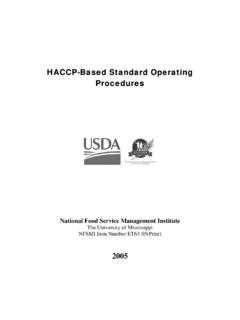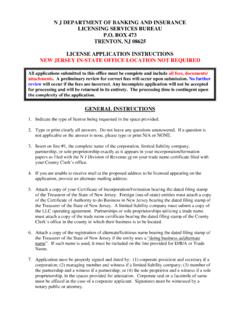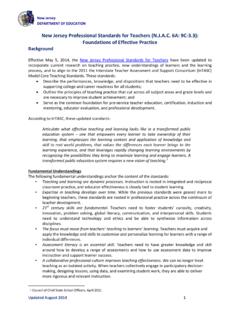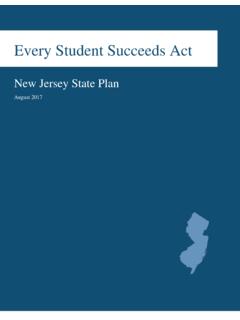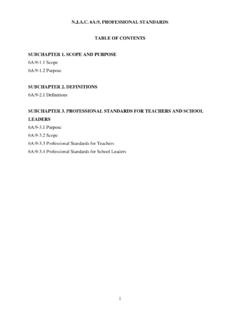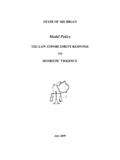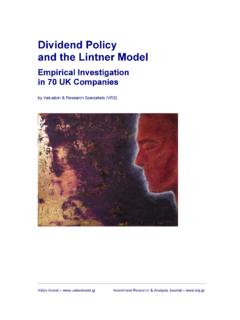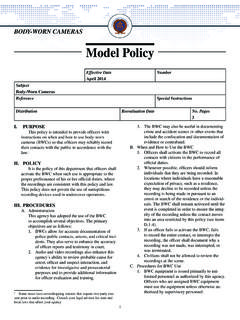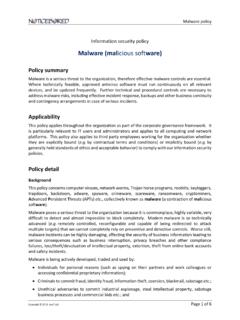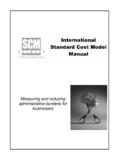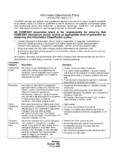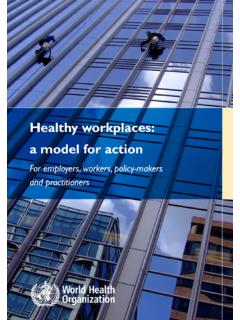Transcription of New and Amended Harassment, Intimidation and Bullying Laws
1 model policy AND GUIDANCE FOR PROHIBITING HARASSMENT, Intimidation AND Bullying ON SCHOOL PROPERTY, AT SCHOOL-SPONSORED FUNCTIONS AND ON SCHOOL BUSES (Revised April 2011) (Available at ) INTRODUCTION This document is designed to provide guidance to local district boards of education in the development, establishment and implementation of policies, procedures and programs for the prevention, intervention and remediation of harassment, Intimidation and Bullying (HIB) behavior in schools, in accordance with , Chapter 122. The document is divided into five discrete parts, as described below: Part 1: Background includes information on the legal context and key points for HIB policies and procedures. Part 2: Use of the model policy and Guidance includes an explanation of this document and guidance for appropriate uses of the document. Part 3: Guidance and Requirements for Local policy and Program Development provides general guidance and summarizes the basic requirements for the development of HIB policies and procedures, including the minimum components of the policies and procedures and issues for consideration, and a summary of statutory requirements other than for the development of policy and procedures.
2 Part 4: model policy Development: Issues for Consideration, Sample policy Language and Requirements contains 10 specific sections, each providing statutory requirements, sample or suggested model policy language, where appropriate, and issues for district boards of education to consider in the development of their locally determined HIB policies and procedures. Part 5: Resources on HIB lists books, programs, articles and Web sites of interest pertaining to HIB. PART 1 BACKGROUND On January 5, 2011, Governor Chris Christie signed into law , Chapter 122, an act concerning HIB in school settings that Amended various parts of the statutory law. In particular for school policies and procedures, the act Amended 18A:37-13 et seq., which include the requirements for the prevention and intervention of HIB on and off school grounds*, at school-sponsored functions and on school buses. 2 To assist each district board of education in revising its HIB policy to comply with the new statute, the Amended l egislation required the Commissioner of Education to revise the New Jersey Department of Education s (NJDOE) model HIB policy applicable to grades kindergarten through twelve (K-12).
3 Therefore, this document includes revisions to the model policy originally published in September 2003, revised in April 2006, April 2007 and November 2008, and includes appropriate references to statutes and emergent information on HIB. Under 18A:37-15, each district board of education continues to be granted local control over the contents of the HIB policy , but, at a minimum, the components listed in the Amended statute must be included in the school district s policies and procedures prohibiting HIB. Additionally, district policy must continue to conform to all applicable case law and statutes, including Saxe v State College Area School Dist., 240 F. 3d 200 (3d Cir. 2001); Davis v. Monroe County Board of Education, 526 629 (1999); v. Toms River Reg l Schs. Bd. of Educ., SUPREME COURT OF NEW JERSEY, 189 381; 915 535; 2007 LEXIS 184, November 13, 2006, Argued, February 21, 2007, Decided; 2C:33-4, Harassment; 10:5-1 et seq., Law Against Discrimination; 18A:36-20, Discrimination; prohibition; 18 , No child to be excluded from school because of race, etc.
4 Additional resources are identified at the end of this document. It is important to note that the Amended law supplements the provisions under the previous HIB statute, with the exception of the following changes: HIB Off School Grounds The HIB definition and the HIB policies and procedures must address incidents that occur off school grounds when they substantially disrupt or interfere with the orderly operation of the school or the rights of other students. HIB Investigation An HIB investigation, previously required to be conducted by the principal or the principal s designee, is to be initiated by the principal or the principal s designee but conducted by the school anti- Bullying specialist, who is appointed by the principal. Range of Responses to HIB Rather than being established by the district board of education, the principal, in consultation with the school anti- Bullying specialist, is responsible for identifying the range of ways in which a school will respond once an HIB incident is identified.
5 All Acts of HIB The HIB definition clarifies that the HIB policies and procedures apply to a single incident or a series of incidents. _____ * The term school grounds, pursuant to 6 , means and includes land, portions of land, structures, buildings, and vehicles, when used for the provision of academic or extracurricular programs sponsored by the school district or community provider and structures that support these buildings, such as school district wastewater treatment facilities, generating facilities, and other central service facilities including, but not limited to, kitchens and maintenance shops. School property also includes other facilities as defined in 6 , playgrounds, and recreational places owned by local municipalities, private entities or other individuals during those times when the school district has exclusive use of a portion of such land. _____ 3 PART 2 USE OF THE model policy AND GUIDANCE Careful consideration of all issues must inform the final policy and practices of the school district.
6 Part 3 provides a description of the policy contents and a description of the requirements of the new law, including policy and program development, staffing and training. The model policy language in Part 4 of this document provides only general points for the district board of education s policy , rather than all-inclusive policy language that addresses local values, issues and priorities. As a result of the local consultation requirements and the impracticality of anticipating the divergent and changing values, needs, priorities and practices of each school district in New Jersey, this document is presented as a summary guide and model , and is not a complete and final policy to be adopted by the district board of education. The information provided in sections 1-10 of Part 4 includes an explanation of the following: The statutory provisions that district policies and procedures must include; Suggested or sample model policy language, where appropriate; and Issues for the district to consider in developing policies and procedures that fit its own unique situation and that are consistent with existing district board of education policies.
7 Nothing in the model policy language or in the legislation and regulations is meant to preclude a school district from including additional provisions, or from using language and formats that are consistent with the district board of education s approved policies and procedures. Part 5 contains information on resources regarding HIB. PART 3 GUIDANCE AND REQUIREMENTS FOR LOCAL policy AND PROGRAM DEVELOPMENT policy Context The NJDOE recognizes that decisions about consequences and actions to be taken in response to violations of policies prohibiting HIB should take into consideration the unique circumstances of the acts and the persons involved, as well as the unique conditions in and characteristics of each school district. Each district board of education s policy , however, must comport with existing school district policies, including those that address the provisions of 6A:16, Programs to Support Student Development, in general, and 6 , Code of student conduct, in particular, as well as the provisions of the district s Memorandum of Agreement Between Education and Law Enforcement Officials, pursuant to 6A:16-6, Law Enforcement Operations for Substances, Weapons, and Safety and related district performance review indicators in the New Jersey Quality Single Accountability Continuum, per 6A:30.
8 4 Once school district officials have clearly articulated the preferred behaviors for all students in grades K-12, staff members should be trained in skills and strategies for developing student self-discipline and to apply best practices for positive behavioral interventions. It is important to use the policy as an opportunity for preparing staff to effectively intervene with instances of HIB. It is equally important to use the policy as a prevention tool, by explaining to students the school district s expectations for their behavior and teaching skills and providing sufficient support for students to fulfill the behavioral expectations, consistent with the provisions of the district board of education s code of student conduct, including HIB and 6 , Code of student conduct. For students to demonstrate preferred behaviors, it is important that they have a clear understanding of the school district s expectations under the policy , the reasons for and benefits of the policy , the consequences for violations of the policy , as well as have opportunities to learn preferred behaviors, both before and after the advent of conduct problems.
9 It is through explanation, dialogue and skill building among students and staff that the school district can clearly distinguish, for example, "friendly teasing" and "rough and tumble play" from HIB. It also is through discussion that the school district can help students and staff discern between "telling" or responsible "reporting" (which is intended to keep someone from getting hurt) of acts of HIB from "ratting" or "tattling." The school district is encouraged to use experiential learning techniques, such as role play situations and other demonstration and modeling strategies in its information activities for students and staff designed to prevent and remediate problem behaviors. The preferred pro-social behaviors are most likely to be successfully adopted when school officials engage in data-driven practices for improving school culture and climate and when all school staff members are committed to consistently modeling preferred behaviors and engaging students, colleagues and community members in evidence-based educational practices.
10 Local policy Development The following descriptions of applicable requirements make it clear that the content and format of local policies and procedures must be developed locally and not be adopted based solely on the model policy language provided: Each district board of education must develop its HIB policy through a process that includes representation of parents** and other community members, school employees, school volunteers, students and school administrators, in accordance with 18A:37-15(a), and the policy must be consistent with the provisions of 6A:16-7, Student Conduct, as appropriate. Each district board of education s code of student conduct must include a policy and procedures regarding HIB, and must be based on parent, student and community involvement which represents the composition of the schools and communities, pursuant to 6 (a)1. The code of student conduct, which must include the HIB policy , must be based on locally determined and accepted core ethical values adopted by the district board of education, pursuant to 6 (a)2.
